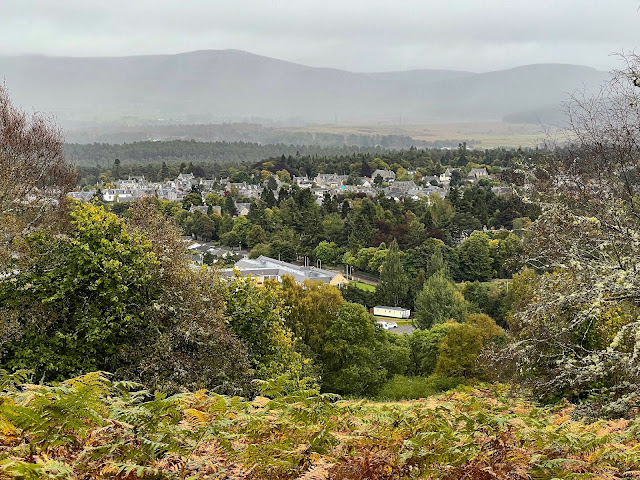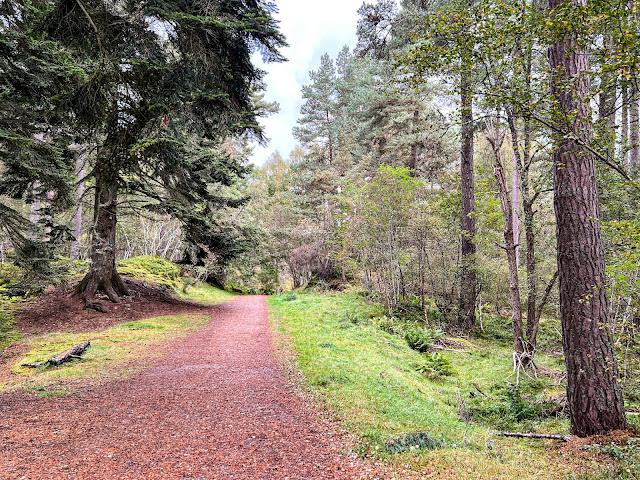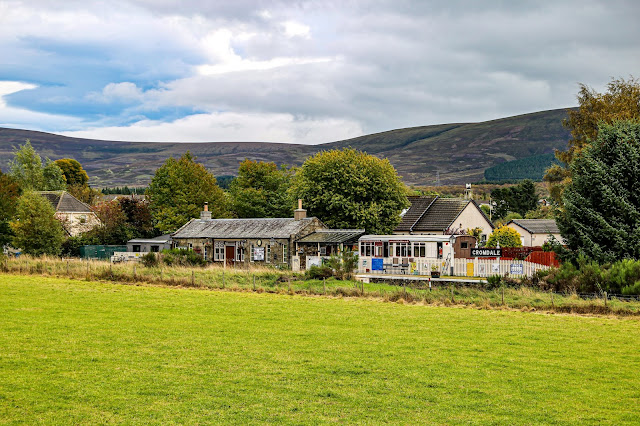Grantown on Spey lies on the River Spey 13 miles northeast of Aviemore and is overlooked by the Cairngorm mountains. By visiting the local museum you get to appreciate some of its rather interesting history.
 |
| Grantown Museum. |
 |
| Granton Bell (1824) |
 |
| Speyside House |
It was laid out as a planned village in 1766 by Sir James Grant whose intention was to crate a market town and industrial centre at the heart of his vast Strathspey estate. Like many other northern Scottish towns the arrival of the railway in 1863 made this area attractive to visitors for its fishing, shooting and hill walking, not quite the draw for working class families? Even after the railway closed in 1965 tourists still visited this area with skiing making Grantown on Spey an all year holiday resort.
Half a mile walk from the town square and the shops, which includes a large Co-Op Store, is the Grantown on Spey Camp Site. Affiliated to the Caravan and Motorhome Club it can only be described as a beautiful place to stay. It provides large fully serviced pitches and clean facilities with hot fast flowing showers and certainly one of the best sites we have had the privilege to stay on. This part of the Cairngorms offers visitors a great deal to explore, some great walks, quiet roads for cycling and a bus service directly into Aviemore.
 |
Viewpoint Walk. |
Unfortunately the rain did spoil our plans to some extent but we still managed to explore some of the very attractive countryside.
Just a short walk from the town is the Anagach Woods which is one of Scotlands Special Protective Areas (SPA) with beautiful natural Scots pine trees, and is also the haunt of the Capercaillie.
There are three way-marked trails through the woods. The longest trail allows you to link up with the Speyside Way and through Crow Wood, across the Spay onto the village of Cromdale and more Jacobite history. The first thing you witness is the plaque on the wall of the Cromdale Kirk.
The Battle of Cromdale.
Early on the 1st of May 1690, under the cover of darkness, the government army of mounted dragoons, led by Grant guides crossed the River Spey. They by-passed guards in the vicinity of the Cromdale Kirk and, upon the Laughs of Cromdale at Lethendry, made a surprise cavalry charge on the main body of the sleeping Jacobite army. Killing some 400 and capturing about 100, the Government troops forced the remainder to flee, many of whom were near naked having been compelled to abandon their plaids in the confusing circumstances.
This complete rout ended the first Jacobite war in the Highlands and destroyed any chance of King James regaining the throne, occupied jointly by his daughter, Mary and her Dutch husband, William of Orange. The battle could be described as the Culloden of the first Jacobite Rising in Scotland.
Cromdale Village was developed in association with forest planting on the Strathspey Estate in the early 19th century. Although the railway line that passed through the village is no longer functioning, under the infamous Beeching Cuts passenger services ceased on the 18th October 1965 and with goods services stopped in November 1968, the station and it platform not only still exists but the external has been carefully renovated to preserve its original look. Next to the station is a railway carriage. Internally both the carriage and the station have been tastefully turned into spaces for holiday lets. The owner was on site at the time of our visit and was kind enough to show us around.
https://www.cromdalestation.co.uk/
If you worry to much about the weather while touring Scotland you would never get out to see the many surprises that await you around each corner. Packing our rain gear in our saddle bags we set off on our bikes heading for an afternoon ride to the Boat of Garten. Just before Nethy Bridge up high above the roadway is Castle Roy which is being renovated by some very skilled stonemasons and joiners.
“Castle Roy is an 12th century fortress built by the Clan Comyn on a small glacial mound to the north of the modern village of Nethy Bridge. In 1420 the whole area came under the stewardship of the Clan Grant who are still the clan of this area today.” For full information please follow the attached link:
We also met the Highland Coo, Murdo the guardian of the castle, who was rejected at birth and has since been hand reared. He is used to people so you can, if your brave enough, stroke his head, which he appears to like.
Boat of Garten was originally a ferry crossing until it developed as a railway village when the Inverness and Perth Junction Railway opened its main line from Forres to Dunkeld in 1863. Three years latter the village became a junction on the opening of the Great North of Scotland Railway line to Nethy Bridge and beyond. Passenger rail travel ceased in 1965, but thanks to enthusiastic volunteers, in 1973 the Strathspey Railway Society reopened the line from Broomhill via the Boat of Garten to Aviemore for tourist use . And what a wonderful sight it was to see a steam train pull into and out off the station.
https://www.strathspeyrailway.co.uk/
Near by is Loch Garten and a nature reserve which is an osprey nesting site with viewing facilities that unfortunately were closed when we visited on our bikes. The weather stayed dry long enough to have lunch entertained by small birds. Our 11 mile return cycle journey was very wet and cold! You canny win them all!
 |
The two entrances to the Castle Grant Estates. |
It was from 1694 this mysterious Manor House became known as Castle Grant and became the principal residence of the Chiefs of Grant for almost five centuries. Ludovick Grant, the eighth laird, supported the Hanoverians against the Stewarts and fought against the Jacobites in both the Jacobite rising of 1715 and 1745. However Castle Grant did get occupied by the Jacobites. In 1787, Robert Burns visited Castle Grant.
It had to be abandoned in the mid 20th century due to dry-rot infestation and the building fell into disrepair and ruin. The castle was restored by Sir Robert Lorimer in 1912, and its modern history is as interesting as its past.
The property was purchased for £720,000 by businessman Craig Whyte in 2006. The Castle was seized by the Bank of Scotland after Whyte, who had led Rangers F.C. into its administration and liquidation in 2012, refused to make mortgage payments. It was sold in September 2014 to ex-CEO of the Russian Author Society, Sergey Fedotov, who was later arrested for fraud!
 |
| The Old Bridge. |
 |
| The Spey. |
 |
| The beautiful surrounding countryside. |
Certainly Grantown is a place we would be happy to revisit.







































No comments:
Post a Comment